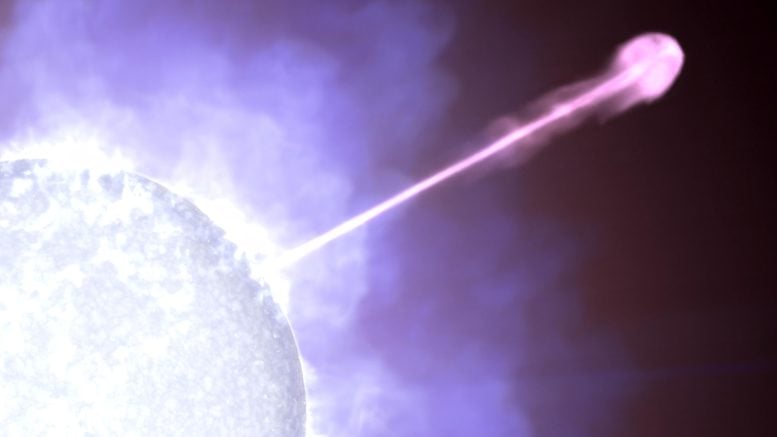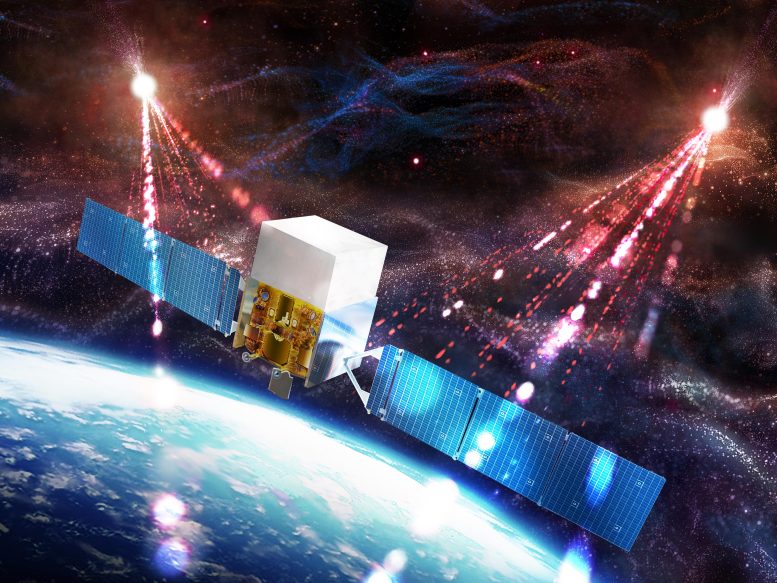
Utilizing data from NASA’s Fermi Gamma-ray Space Telescope, researchers discovered a unique energy peak in the aftermath of the brightest Gamma-Ray burst ever seen, suggesting the annihilation of electrons and positrons. This finding provides new insights into the behavior of cosmic jets and the extreme conditions following such bursts.
In October 2022, astronomers were stunned by what was quickly dubbed the BOAT — the brightest-of-all-time gamma-ray burst (GRB). Now an international science team reports that data from NASA’s Fermi Gamma-ray Space Telescope reveals a feature never seen before.
Unprecedented Spectral Feature Identified
“A few minutes after the BOAT erupted, Fermi’s Gamma-ray Burst Monitor recorded an unusual energy peak that caught our attention,” said lead researcher Maria Edvige Ravasio at Radboud University in Nijmegen, Netherlands, and affiliated with Brera Observatory, part of INAF (the Italian National Institute of Astrophysics) in Merate, Italy. “When I first saw that signal, it gave me goosebumps. Our analysis since then shows it to be the first high-confidence emission line ever seen in 50 years of studying GRBs.”
A paper about the discovery appears in the July 26 edition of the journal Science.

When matter interacts with light, the energy can be absorbed and reemitted in characteristic ways. These interactions can brighten or dim particular colors (or energies), producing key features visible when the light is spread out, rainbow-like, in a spectrum. These features can reveal a wealth of information, such as the chemical elements involved in the interaction. At higher energies, spectral features can uncover specific particle processes, such as matter and antimatter annihilating to produce gamma rays.
“While some previous studies have reported possible evidence for absorption and emission features in other GRBs, subsequent scrutiny revealed that all of these could just be statistical fluctuations. What we see in the BOAT is different,” said coauthor Om Sharan Salafia at INAF-Brera Observatory in Milan, Italy. “We’ve determined that the odds this feature is just a noise fluctuation are less than one chance in half a billion.”
The Nature and Impact of Gamma-Ray Bursts
GRBs are the most powerful explosions in the cosmos and emit copious amounts of gamma rays, the highest-energy form of light. The most common type occurs when the core of a massive star exhausts its fuel, collapses, and forms a rapidly spinning black hole. Matter falling into the black hole powers oppositely directed particle jets that blast through the star’s outer layers at nearly the speed of light. We detect GRBs when one of these jets points almost directly toward Earth.
The BOAT, formally known as GRB 221009A, erupted on October 9, 2022, and promptly saturated most of the gamma-ray detectors in orbit, including those on Fermi. This prevented them from measuring the most intense part of the blast. Reconstructed observations, coupled with statistical arguments, suggest the BOAT, if part of the same population as previously detected GRBs, was likely the brightest burst to appear in Earth’s skies in 10,000 years.
The brightest gamma-ray burst yet recorded gave scientists a new high-energy feature to study. Learn what NASA’s Fermi mission saw, and what this feature may be telling us about the burst’s light-speed jets. Credit: NASA’s Goddard Space Flight Center
Insights Into Cosmic Particle Interactions
The putative emission line appears almost 5 minutes after the burst was detected and well after it had dimmed enough to end saturation effects for Fermi. The line persisted for at least 40 seconds, and the emission reached a peak energy of about 12 MeV (million electron volts). For comparison, the energy of visible light ranges from 2 to 3 electron volts.
So what produced this spectral feature? The team thinks the most likely source is the annihilation of electrons and their antimatter counterparts, positrons.
“When an electron and a positron collide, they annihilate, producing a pair of gamma rays with an energy of 0.511 MeV,” said coauthor Gor Oganesyan at Gran Sasso Science Institute and Gran Sasso National Laboratory in L’Aquila, Italy. “Because we’re looking into the jet, where matter is moving at near light speed, this emission becomes greatly blueshifted and pushed toward much higher energies.”
Future Research Directions and Collaboration
If this interpretation is correct, to produce an emission line peaking at 12 MeV, the annihilating particles had to have been moving toward us at about 99.9% the speed of light.
“After decades of studying these incredible cosmic explosions, we still don’t understand the details of how these jets work,” noted Elizabeth Hays, the Fermi project scientist at NASA’s Goddard Space Flight Center in Greenbelt, Maryland. “Finding clues like this remarkable emission line will help scientists investigate this extreme environment more deeply.”
The Fermi Gamma-ray Space Telescope is an astrophysics and particle physics partnership managed by Goddard. Fermi was developed in collaboration with the U.S. Department of Energy, with important contributions from academic institutions and partners in France, Germany, Italy, Japan, Sweden, and the United States.